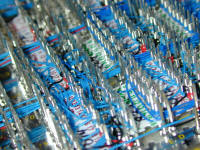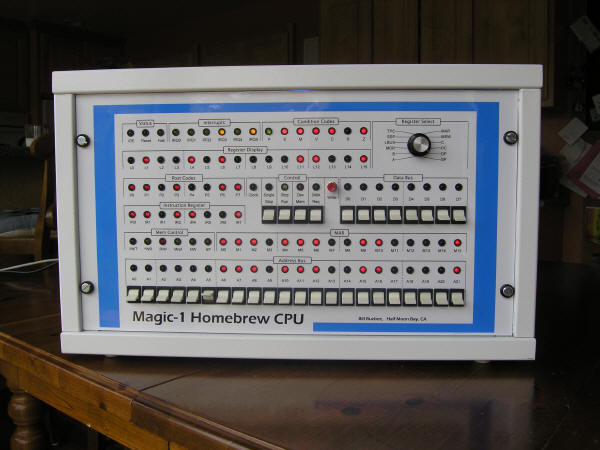 Magic-1 is a
completely homebuilt minicomputer. It doesn't use an off-the-shelf
microprocessor, but instead has a custom CPU made out of 74
Series TTL chips. Altogether there are more than 200 chips in Magic-1
connected together with thousands of individually wrapped wires. And, it
works. Not only the hardware, but a full software stack. There's a ANSI C
cross-compiler for Magic-1 (retargeted
LCC), a fully
multi-user, multi-tasking port of the
Minix 2 operating system. a TCP/IP stack and hundreds of programs. Magic-1 is a
completely homebuilt minicomputer. It doesn't use an off-the-shelf
microprocessor, but instead has a custom CPU made out of 74
Series TTL chips. Altogether there are more than 200 chips in Magic-1
connected together with thousands of individually wrapped wires. And, it
works. Not only the hardware, but a full software stack. There's a ANSI C
cross-compiler for Magic-1 (retargeted
LCC), a fully
multi-user, multi-tasking port of the
Minix 2 operating system. a TCP/IP stack and hundreds of programs.
Except when
I'm working on it, Magic-1 is connected to the net. It serves web pages at http://www.magic-1.org,
and by clicking here you can telnet in and
play Original Adventure
or run a few other old classics such as
Eliza,
Conway's Life or
Hunt the Wumpus.
To log in, use the id "guest" and the password "magic". Before the Minix
port was completed, Magic-1 was running a very simple homebrew operating system.
It also had a simple guestbook program. Many thousands of people have
telnetted into Magic-1 from around the world, and between 2004 and the summer of
2007 they left 1388 guestbook messages. I've
preserved the messsages here.
This web site
has served as the development repository for the project, and contains lots of
pictures documenting the construction, as well as full documentation and
diaries stretching back to the project's beginning in 2001.
You can also find a few videos of Magic-1 running, including the first time it
worked.
Start here,
and then check out the Overview, New Stuff and Photo Gallery. To dig deeper, browse through
Technical Info,
Construction - and if you're really
interested, you can even download a complete set of Magic-1's schematics.
Although
Magic-1 is a custom computer, it no longer is one-of-a-kind. Aidil Jazmi
of Universiti Teknologi Petronas in
Malaysia duplicated Magic-1 as a school project.
You can read about his work
here.
NEW (8/30/2016): Because of automated script attacks at the standard telnet port (23), Magic-1 will now be using an odd telnet port number: 51515. So, to telnet in to magic-1, do: "telnet magic-1.org 51515".

 Magic Magic
In the summer of 1980 I celebrated my freshly minted B.S. in Journalism by
blowing most of the cash I collected in graduation gifts on a TRS-80 Model 1
computer. Sitting on the floor of my apartment I fired it up, typed in
the sample BASIC program and then "RUN".
WHAT IS YOUR NAME?
"BILL", I responded.
HI BILL
Wow! I was blown away. This was just a machine, but I
could interact with it using language that we
both understood. As a Liberal Arts graduate with next to no technical
background, I found this completely astonishing. Over the next year, I
continued to play with my TRS-80 Model 1 while working as a journalist on a small-town Kansas
newspaper. I decided that I really wanted to learn more
about how computers worked, so I went back to college and picked up a M.S. in
Computer Science.
More than 20 years later, I found myself with an urge to touch
that magic again by building my own computer from scratch. By
"scratch", I meant designing my own instruction set, wire-wrapping a
CPU out of a pile of 74 series TTL devices and writing (or porting) my own assembler, compiler,
linker, text editor and operating system.
I'm calling this computer the "Magic-1", or M-1 for short. It's a
one-address, microprogrammed machine with one-byte opcodes. It
features 8/16-bit data operations, functioning on an 8-bit wide data bus with
16-bit addresses (mapped via 2K-byte pages into a 22-bit physical address
space). Code and data address spaces can be shared or disjoint,
giving each process up to 128K bytes of addressing. User and
supervisor modes exist, along with hardware address translation, memory-mapped
IO, and support for DMA and externally-generated interrupts. As far as
components go, it is built entirely out of 74LS and 74F-series TTL devices plus
modern SRAM and EPROMs for the microcode store. After redesigning
the memory access mechanism several years into the project, Magic-1 runs at 4.09
Mhz.
Goals
OK, so I understand wanting to do your own CPU, buy why
on earth are you doing it this way? I mean, why TTL - why not
FPGA? And really, 16-bit virtual addresses in a 22-bit physical
address space! What's the deal with that?
I guess any project should start off with some notion what of
what you're trying to achieve. My high-level project goals were:
 | Touch the magic. By this I meant to gain a deeper
understanding of how computers work, and specifically computers similar to
those of the late 70's and early 80's that first fired my interest.
For this reason, the Z80 loomed large in my mind throughout the design
process, and running with an 8-bit data bus and 16-bit addresses just seemed
right. Although I was largely trying to use parts that would have been
current in that time, I wasn't shooting for historical accuracy.
My choice of 74xx is a nod to the past, and my choice of 74Fxx had
more to do with availability. |
 | TTL rather than FPGA. My reasons here pretty
much boil down to "because that's what I want to do."
FPGAs do sound fun, but I really am drawn towards using technology
that is similar to that which was current when I first became
introduced to computers. Perhaps for Magic-2.... |
 | Learn more about computing areas in which I have interest,
but much ignorance. From my years as a software developer, I've gained a passing familiarity with language tools.
However, I really wanted to better understand hardware and operating
systems. To this end, I pushed the hardware complexity to what I
consider the limits of my hobbyist abilities, and included
support for preemptive multitasking and paging to enable me to support a
"real" operating system for
my machine. |
 | Build something real. I'm proud of some of the
software I've written, but I thought it would be nice if I could have something
physical to show for all my work. That's part of the reason I went
with wire-wrap. My wife and kids may not be impressed by my
instruction set design, but all those wires ought to at least get some sort
of reaction from them ("Geez Dad, you're such a nerd. Would
you please put that thing away before my friends come over and you embarrass
me to death?"). |
 | Functionality over Speed. I don't really need
this machine to be as fast as possible. Efficient, yes - but wherever
possible I traded off speed for simpler circuits. |
 | Compactness. One of my pet peeves is how
bloated modern software is. I think there's a lot you can do with 128K
bytes of addressing, and I liked the idea of keeping things compact and
utilitarian. I've tried to construct an expressively dense set of
1-byte opcodes. |
At the end of the day, I wanted a working, and useful,
machine that I understood completely. Oh, and it had to have a real
front panel with lots
and lots of cool blinky lights.

P.S. Although this site gets few
visitors, I have on occasion gotten the comment that:
-
I have way too much time on my hands
-
I must be single.
Well, wrong on both counts! Married - 3 kids & two
dogs, and not nearly enough time. I manage to make progress on the project
by putting in the odd hour here and there and treating it as the multi-year
effort that it is. It also helps that as far as my wife knows, I'm actually doing paying work
on the laptop and not just screwing around with my hobby projects :-).

P.P.S. Corrections:
-
When I said "my wife" in the previous section, I
actually meant to say "my beautiful, intelligent and under
appreciated
wife who not only does way more than her share of the work around here,
but also knows that this web site exists and checks it out from time to
time."
-
Regarding my suggestion that my "paying work"
ruse is successful:
"Do you really think I don't know when
you're playing with your toys? On the rare occasion when you are
doing real work, you slouch. When you are playing with your hobby
project you get all intense. You know you can't fool me. Never
forget that."
Now, in my own defense, I'd like to say that, uh - hold on
for a second
what? - the dishes? No, no I didn't
forget. I was just getting up to do them. And Will's bath?
Yes, of course, that too. Yes, dear - on my way......

Got any advice, abuse or comments for me?
Send email


Homebuilt CPUs WebRing
JavaScript by Qirien Dhaela
Join the ring?
David Brooks, designer of the Simplex-III homebrew computer, has founded the
Homebuilt CPUs Web Ring.
To join, drop Dave a line,
mentioning your page's URL. It will then be added to the list. You will also need to copy this code fragment into your page.
|

![]()
![]()
![]()
![]()